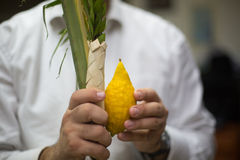How to Shake a Lulav
Sukkot begins tonight! You've built and decorated a lovely sukkah, but perhaps you're wondering what to do next. Here's a quick guide on how to begin your celebration of the most fragrant and hospitable Jewish holiday of them all:
Jerusalem balcony sukkah
Mitzvah #1: Rejoice!
Sukkot is zeman simchatenu, the season of our joy. All of the pilgrim festivals—Passover, Shavuot, and Sukkot—are times of joy, but for Sukkot the commandment to rejoice is given three times (Lev. 23:40; Deut. 16:14-15). How do you fulfill this mitzvah? By embracing this time of rest and rejoicing, welcoming guests to your sukkah, and giving thanks to God for His abundant mercy and provision for you and your family.
Mitzvah #2: Dwell in the Sukkah
As you enter your sukkah for the first time tonight, you can fulfill the mitzvah of dwelling in it by eating a meal inside of it. Begin your meal by reciting Kiddush over a cup of wine. Don't forget to add the blessing for the sukkah, too:
“Baruch atah Adonai Elohenu melech ha-olam, asher kid’shanu b’mitzvotav vitzivanu leyshev ba-sukkah. (Blessed are you Lord our God, King of the universe, who has hallowed us by your commandments, and has commanded us to dwell in the sukkah.”
Next comes the Shehecheyanu (the blessing for new things and new seasons):
“Baruch atah Adonai Elohenu melech ha-olam, shehecheyanu, v’kiyamanu, v’higiyanu lazman ha-zeh. (Blessed are you, Lord our God, King of the universe, who has kept us in life, and preserved us, and enabled us to reach this season.)”
Congratulations, you've fulfilled a mitzvah! But wait ... there's more! The next morning we're ready to fulfill the third mitzvah ...
Mitzvah #3: Shake the Lulav
And you shall take for yourselves on the first day the fruit of beautiful trees, branches of palm trees, the boughs of leafy trees, and willows of the brook; and you shall rejoice before the Lord your God for seven days. (Leviticus 23:40)
To fulfill this mitzvah, acquire a lulav set, which includes the four species described, with the “fruit of beautiful trees” understood as the citron or Etrog. On the first morning of Sukkot, gather your lulav and etrog. Put the lulav in your right hand and the etrog in your left hand, with the pitom (pointy part) pointing down. Recite this blessing:
“Baruch atah Adonai Elohenu melech ha-olam, asher kid’shanu b’mitzvotav vitzivanu al n’tilat lulav. (Blessed are you Lord our God, King of the universe, who has hallowed us by your commandments, and has commanded us to take up the lulav.)”
here the pitom is pointing up
After reciting the blessing, point the pitom of the etrog upwards (careful not to break it off) and unite it with the rest of the lulav set. Then wave it three times in each direction - east (toward Jerusalem), south, west, north, up, and down. The first time you do this, make sure to say the Shehecheyanu.
Congratulations! You've just fulfilled another mitzvah. Remember to wave the lulav every morning for the rest of Sukkot (ask your local Messianic rabbi if it's your community's custom to abstain from waving the lulav on Shabbat).
UMJC Rabbinic Counsel Rabbi Russ Resnik
Why does God ask us to engage in this funny ritual?
Rabbi Russ Resnik: "One midrash says that the fragrance of the four species represents knowledge of Torah and the fruit of the different species represents good deeds, thus portraying four types of Jews: the etrog is a fruit with fragrance, signifying those godly Jews who have both knowledge and good deeds; the palm has fruit and no fragrance, representing those with good deeds but no knowledge of Torah; the myrtle has fragrance (knowledge) and no fruit (good deeds); and the willow has neither. The four types are bound together and extended in praise before the Lord, representing all Israel united in acknowledging the true king and giver of life. (Vayikra Rabbah 30:12)
"Another midrash compares the etrog to the heart, the palm to the spine, the myrtle leaves to the eyes, and the willow leaves to the lips. And so we each unite our soul in giving praise to the Lord, who is the source of all (Vayikra Rabbah 30:14). Waving in all six directions underlines the completeness of our worship, and waving three times in each direction yields the number 18, which signifies chai, or life, in Hebrew. We add to the four usual directions by waving the lulav set upwards toward the heavens, and downward, as a final direction, signifying our hope for blessings to descend from on high. After this extended blessing, the whole assembly recites Hallel (Psalms 113–118, all or part), while those with lulav sets continue to raise them up with joy."
“Halleluyah! Praise, O servants of Adonai, praise the Name of Adonai. Blessed be the Name of Adonai from now and forever. From the rising of the sun to its going down the Name of Adonai is to be praised. (Ps. 113:1–3, TLV)”






